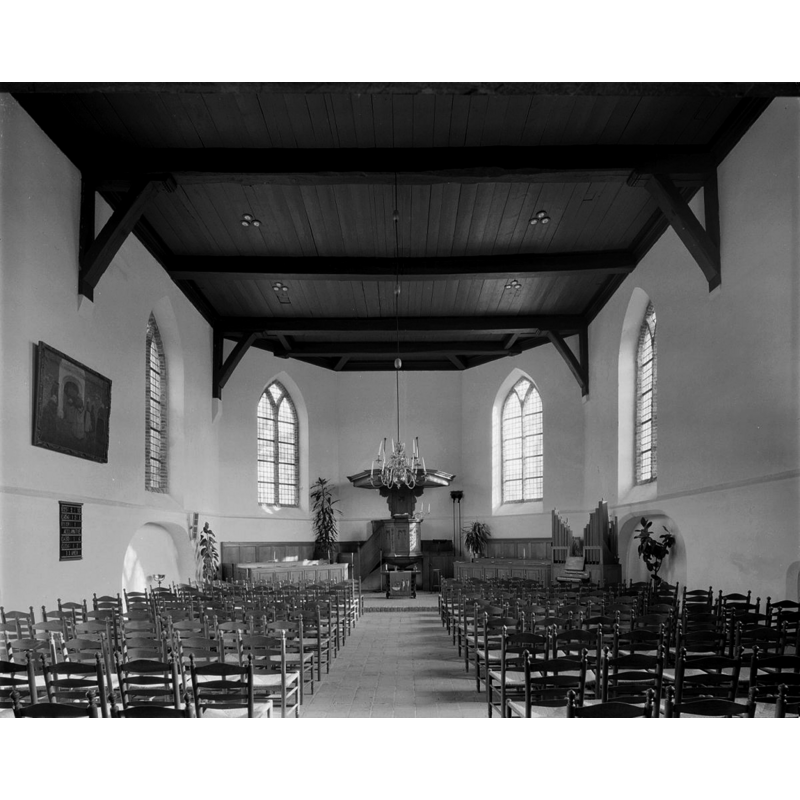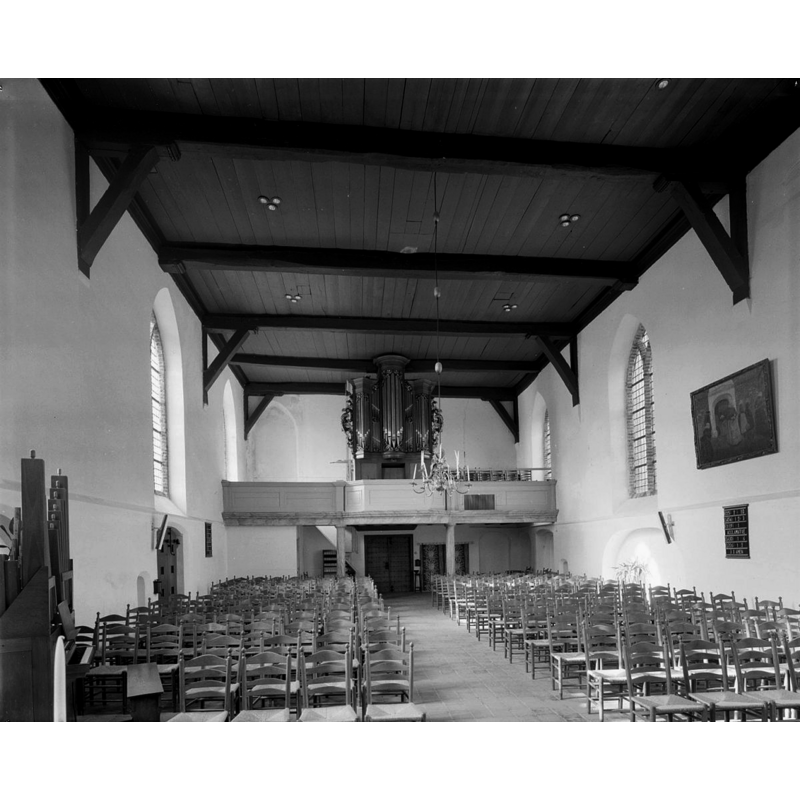Westerbork No. 1

Image copyright © Michielverbeek, 2011
CC-BY-SA-3.0
Results: 4 records
view of church exterior - south view
view of church interior - nave - looking east
Copyright Statement: Image copyright © Rijksdienst voor het Cultureel Erfgoed, 2015
Image Source: B&W photograph taken February 1984 by A.J. (Ton) van der Wal, In Rijksdienst voor het Cultureel Erfgoed [https://commons.wikimedia.org/wiki/File:Interieur_naar_het_oosten_-_Westerbork_-_20254032_-_RCE.jpg] [accessed 2 July 2015]
Copyright Instructions: CC-BY-SA-3.0
view of church interior - nave - looking west
Copyright Statement: Image copyright © Rijksdienst voor het Cultureel Erfgoed, 2015
Image Source: B&W photograph taken February 1984 by A.J. (Ton) van der Wal, In Rijksdienst voor het Cultureel Erfgoed [https://commons.wikimedia.org/wiki/File:Interieur_naar_het_oosten_-_Westerbork_-_20254033_-_RCE.jpg] [accessed 2 July 2015]
Copyright Instructions: CC-BY-SA-3.0
view of font - fragment
Scene Description: not a fragment of the original Bentheim font from Westerbork, but quite likely of a later font or stoup [cf. FontNotes]
Copyright Statement: Image copyright © J. Knottnerus, 2008
Image Source: digital photograph 2008 in J. Knottnerus [http://home.kpn.nl/n1357/westerbork_13.htm] [accessed 2 July 2015]
Copyright Instructions: No known copyright restriction / Fair Dealing
INFORMATION
FontID: 19912ASS
Object Type: Baptismal Font1
Museum and Inventory Number: Drents Museum, Assen
Church/Chapel: originally from Stefanuskerk [later in a museum; back in the church on loan since 1952]
Church Patron Saints: St. Stephen
Church Location: Hoofdstraat 12, Westerbork, Drenthe, Netherlands
Country Name: Netherlands
Location: Drenthe
Directions to Site: Located in the municipality of Midden-Drenthe since 2000 [previously a separate municipality]
Font Location in Church: [cf. FontNotes]
Century and Period: 13th century, Late Romanesque / Early Gothic?
Workshop/Group/Artisan: Bentheim font, Sögel Type II [Drake]
Cognate Fonts: Emmen, Merzen (Drake, 2002) / basin similar to Haselünne's
Credit and Acknowledgements: We are grateful to Joost Limburg, of Romanesque Baptismal Fonts in the Netherlands / Romaanse doopvonten in Nederland [www.romanicoportugal.info/zdutchfonts.htm] [accessed 2 July 2015] , for bringing this font to our attention
Church Notes: it was called "capella de Burch" in 1206, when it was a wooden chapel-of-ease to Beilen's parish church; present building is 15thC except for the lower part of the tower, which is 13thC
Font Notes:
Click to view
Drake (2002) lists a Bentheim font at Assen's Drente Museum as a Sögel Type II, Bentheim baptismal font, but does not mention Westerbork; if this is the same font the font does not match any of Drake's types; the basin, however, is very similar to the one at Haselünne, which Drake categorises as Type Berge I, even though the base of Westerbork's font is quite different in that, instead of the usual lions, or lion-like shapes, it is supported on the shoulders of for seated humans looking outwards, their forearms resting on their thighs, at 90-degree angles of the round-to-square base; damage is chiefly found around the upper rim, and most likely be due to the stone cracking at the iron staples of the old cover, though this may have been worsened by people using the fine sandstone to sharpen their farm implements later. Noted in Steensma (2007). Listed in Joost Limburg's Romanesque Baptismal Fonts in the Netherlands / Romaanse doopvonten in Nederland [www.romanicoportugal.info/zdutchfonts.htm] [accessed 2 July 2015] as a fragment of a Bentheim sandstone font originally from Westerbork, Drenthe, now in the Drents Museum in Assen. A [this?] fragment is noted and illustrated in J. Knottnerus [http://home.kpn.nl/n1357/westerbork_13.htm] [accessed 2 July 2015]: "Behalve de bewaard gebleven smeedijzeren stander met doopschaal is een beschadigd stenen vont aanwezig die vermoedelijk vroeger in de kerk van Westerbork als doopvont dienst heeft gedaan. Rond het jaar 2000 kwam de kerk door een melding van het Drents museum de vont op het spoor. Deze stond toen in een landbouwmuseum in het Friese Veenklooster. Naar verluid had zij daarvoor jarenlang dienst gedaan als bloembak in een tuin van een familielid tegenover de kerk. De eigenaar van het landbouwmuseum was van oordeel dat de vont terug moest naar haar oorspronkelijke plaats, volgens hem de kerk van Westerbork. [...] De vont is ovaalvormig met medaillonachtige uitstulpingen aan de korte zijden en is aan de onderkant afgeplat. Zij is rondom versierd met een geometrische patroon tussen twee banden." [summary: a fragment now at the Drents Museum, an oval-shaped basin decorated with medallion-like protrusions on the short sides, and a flat bottom; the sides have a geometric pattern between two bands; said by its earlier owner to be part of a baptismal font earlier in use at Westerbork church; it had been used as garden planter for years in a farm located across from the church, and from there had been moved to an agricultural museum in the Friese Veenklooster]. [NB: though this may have been from the Westerbork church, it is most certainly not the medieval font there and must be a mistake in this source]. Thea Barnard at Hetty's Site [http://blog.seniorennet.be/hetty1943/archief.php?ID=1168411] [accessed 2 July 2015] reports: "Een van de bijzonderheden die ds Barnard vertelde betrof het doopvont uit Bentheimer zandsteen. Ze dateert waarschijnlijk uit het midden van de 13e eeuw. In 1833 werd de doopvont verkocht aan het Drents museum te Assen. Sinds 1952 heeft de kerk haar weer in bruikleen. De prachtig versierde kuip toont tussen de dubbele touwbanden een rankenfries met bladeren en druiventrossen en aan de onderkant een waaierfries. De kuip wordt gedragen door vier mensfiguurtjes, mannen met een muts tot over hun oren die met hun handen op de knieën zittend op een stoel op de vierkante voetplaat rusten. Over de oorzaak van de beschadigde bovenrand vertelde ze dat de boeren hier vroeger hun messen aan slepen. De vont zal vroeger onder de toren hebben gestaan, waar doorgaans de doopkapel gesitueerd was. Ik zie ook dat hier een praktischer bakje in is geplaatst, anders zou je wel een hele grote bak warm water nodig hebben die tegen de tijd dat je het gebruikte voor de dopeling al weer ijskoud zou zijn." [summary: mid-13thC Bentheim sandstone font sold to the Drents Museum at Assen in 1833, back on loan at the church since 1952; NB: the rest of the description and the illustration are actually those of the font at Vries -- cf. Index entry]. [cf. BSI entry for NUIS]
COORDINATES
Church Latitude & Longitude Decimal: 52.850272, 6.608919
Church Latitude & Longitude DMS: 52° 51′ 0.98″ N, 6° 36′ 32.11″ E
UTM: 32U 338992 5858293
MEDIUM AND MEASUREMENTS
Material: stone, sandstone (Bentheim)
REFERENCES
Drake, Colin Stuart, The Romanesque Fonts of Northern Europe and Scandinavia, Woodbridge, Suffolk: Boydell Press, 2002


![not a fragment of the original Bentheim font from Westerbork, but quite likely of a later font or stoup [cf. FontNotes]](/static-50478a99ec6f36a15d6234548c59f63da52304e5/compressed/1150702022_compressed.png)